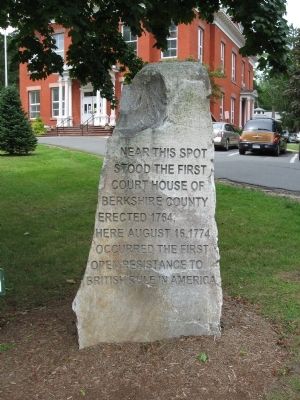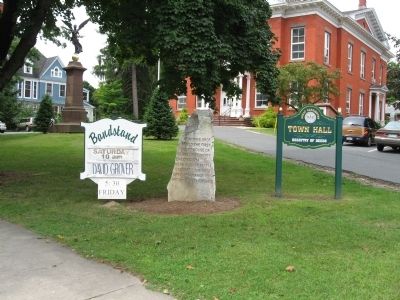Great Barrington in Berkshire County, Massachusetts — The American Northeast (New England)
First Court House of Berkshire County
Topics. This historical marker is listed in these topic lists: Colonial Era • War, US Revolutionary. A significant historical year for this entry is 1764.
Location. 42° 11.627′ N, 73° 21.792′ W. Marker is in Great Barrington, Massachusetts, in Berkshire County. Marker is at the intersection of Main Street (U.S. 7) and Castle Street, on the left when traveling north on Main Street. Located in front of Great Barrington Town Hall. Touch for map. Marker is at or near this postal address: 334 Main Street, Great Barrington MA 01230, United States of America. Touch for directions.
Other nearby markers. At least 8 other markers are within walking distance of this marker. Great Barrington Civil War Memorial (within shouting distance of this marker); You Stand Free Because They Served (within shouting distance of this marker); Great Barrington World War I Monument (within shouting distance of this marker); The Mahaiwe Theater (within shouting distance of this marker); First Congregational Church (about 700 feet away, measured in a direct line); W.E.B. Du Bois Birthsite (approx. 0.2 miles away); Laura Ingersoll Secord (approx. 0.2 miles away); Great Barrington Bi-Centennial (approx. 0.2 miles away). Touch for a list and map of all markers in Great Barrington.
Regarding First Court House of Berkshire County. On August 16, 1774, the townspeople of Great Barrington assembled at the courthouse on court day. They locked the doors and refused admittance to Judge Ingersoll, a crown judge. Tradition says they dragged his cocked hat and powdered wig through the mud; placed him backwards on an old horse and rode him out of town amid jeers.
The next day the judge and his sympathizers attempted to regain entrance to the courthouse. He was arrested and jailed in Litchfield County, Connecticut. Leaving jail he returned to his home in Hartford, and then to England. No more courts answerable to the king were held in Great Barrington. Soon many courthouses in New England closed their doors to English demands, leading to the beginning of the Revolutionary War in April, 1775.
Credits. This page was last revised on September 30, 2020. It was originally submitted on August 30, 2012, by Michael Herrick of Southbury, Connecticut. This page has been viewed 805 times since then and 39 times this year. Photos: 1, 2. submitted on August 30, 2012, by Michael Herrick of Southbury, Connecticut.

